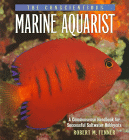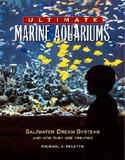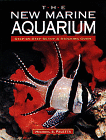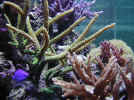180 Gallon Coral Reef Tank
Browse the Categories to the right, or enter a topic here
on this subject ?
The Conscientious
Marine Aquarist

|
|
|
Filtration: The heart of the filtration system consists of a homemade downdraft style skimmer. The skimmer is a dual stack unit that resembles an ETS 1700 and is driven by a Dolphin pump that delivers approx 2500 gph at the head it’s operating at. The skimmer then drains freely back to the sump through a 2” gate valve. No ultraviolet or ozone is being administered but is being considered. Circulation: The main water return pump is merely an Iwaki MD20RLXT, but I plan on replacing this with a much larger pump. There are several various model powerheads in the tank for general water movement. Lighting: Lighting is provided by three 400 watt metal halide “hydroponics”
fixtures. The bulbs are 20,000 degree Kelvin lamps made by Radium. They
are all on for approx. 12 hours per day. The fixtures are placed almost
directly on top of the display, with only a small space to allow cooling
air to circulate into the fixture. There is no glass or acrylic lens filters
on the fixture, but there is a glass stuctural support on the tank’s top
below the center bulb. The bulbs are cleaned of salt spray about once every
week.
Live Rock/Substrate: There is only about 200 lbs. of various Pacific rock sitting directly on top of about 2 inches of CaribSea “sugar fine aragonite”. There is no plenum and only a few sand sifting animals are in residence. Make-up water and additives: All water that enters the tank is reverse osmosis and occasionally calcium hydroxide is mixed in. The RO water is “filtered” by an Ehiem canister filled with crushed coral gravel in an attempt to utilize the RO water’s low pH to dissolve the crushed coral and build up it’s calcium and alkalinity level. Addition of make-up water is completely manual, it is simply siphoned into the sump from a 5 gallon carboy through an airline tubing. There is an MKR-1 calcium reactor delivering at the rate of a very fast drip with a CO2 bubble count of about 1 bubble per second. The reactor is filled with plain, run-of-the-mill heavy grade crushed coral gravel. No other supplements are intentionally added. Everything the corals need, I feel, is supplied through the dissolution of the crushed coral and water changes. My rational is that, when the corals that make up the crushed coral gravel were alive, they utilized whatever minerals they needed from the soup they lived in. If I redissolve them, it’ll be good enough for my corals. There is also the danger of liberating phosphates from the gravel, but, I’ve been using this recipe for a few years now and admittedly, I do have some undesirable algaes (which the tangs love to eat). Water Quality Parameters: I must admit to being a very lazy chemist. I test for alkalinity, calcium and pH on rare occasions. When I do, the pH is typically between 7.9 and 8.3, the alkalinity is usually around 11 or 12 dKH, the calcium is somewhere in the vacinity of 450 ppm (my calcium test kit is a LaMotte and is sometimes very difficult to read). Salinity is maintained at 1.024. Temperature fluctuates quite a bit from winter to summer as I don’t have a chiller yet. Summer temp has been as high as 85 degrees F and winter temp is held at about 78 degrees F. I have many other LaMotte test kits but are no longer used (I’m sure the reagents have long since expired). Fish: There are three tangs, a Yellow (Zebrasoma flavascens), a Blue Hippo (Paracanthurus hepatus) and a White Cheek (Acanthurus nigricans). There is a Six Line wrasse (Pseudocheilinus hexataenia), a Green Chromis (Chromis viridis) and 2 Blue Chromis damsels (Chromis cyaneus) . A single Pajama Cardinal (Apogon sp ? ). A black “lawnmower” Blenny (Salarias fasciatus). A pair of Black Clown Gobies (Gobiodon sp.) and several sandsifting Gobies (Amblyeleotris guttata) (Amblyeleotris randalli). There is also an Arc Eye Hawkfish (Paracirrhites arcatus). Invertebrates: There are brittle stars, sea cucumbers, tiny abalones, astrea snails, millions of tiny unidentified herbivorous snails, amphipods, mysis shrimp and oodles of other plankton that emerge from who knows where at night. Soft Corals: There is a Sinularia coral that grew out from a rock, several colonies of some type of Ricordea and other “mushrooms”, and a colony of Clavularia. A small cluster of Pachyclavularia that is encroaching on a large colony of Acropora. There is also tiny leather coral beginning to grow from one of the rocks. Large Polyp Stonies: There is a Trachyphylia, a large colony of Lobophylia,
a Catalaphylia who’s skeletal growth has gone from a mere few inches
to over a foot long (when it expands, it’s about 18 inches). There are
various “closed brain” corals of the Favia, Favites or Platygyra sp. There
is a Fungia that has budded off a daughter colony.
Small Polyped Stonies: There are about 50 colonies of SPS corals, the majority of which have been obtained from Steve Tyree, Mitch Boley and Clayton Romie as small fragments. They are as follows: Seriatopora hystrix Montipora capricornis Montipora danae Montipora digitata Montipora venosa Acropora humilis Acropora samoensis Acropora digitifera Acropora nobilis Acropora formosa Acropora tortuosa Acropora nana Acropora caroliniana Porites cylindrica Porites sp ? Pseudosiderastrea sp ? Pavona decussata Blastomussa wellsi Merulina sp ? Caulastrea furcata I’ll be adding many more fragments as time marches on. I really enjoy
adding small captive grown fragments and watching them grow into beautiful
little colonies, then into large colonies. They seem to take on a completely
new identity after introduced into a new system. Almost all of my fragments
have morphed into different shapes and vivid colors. I think the intense
lighting helps to bring out the colors and the powerful currents allows
the corals to grow into very realistic shapes, much like what is seen on
the real reef.
Visit the Aquarium Design home page
|
Acrylic aquariums, Fish Tanks, Aquarium Stands
' Build Your Aquarium On-Line '
___________________________________________
Jellyfish,
Jellyfish
Tanks and Plankton Kreisel
___________________________________________
MACNA X

![]()

The Tenth Annual Marine Aquarium Conference Of North America
Presentation DVD's
September, 27, 28 and 29, 1998
Long Beach, California












